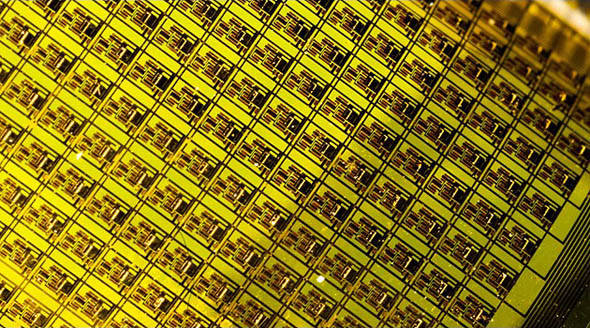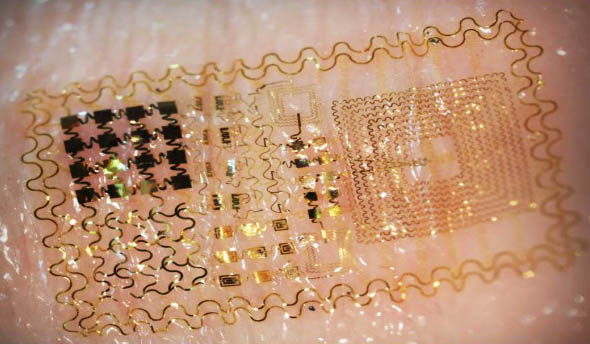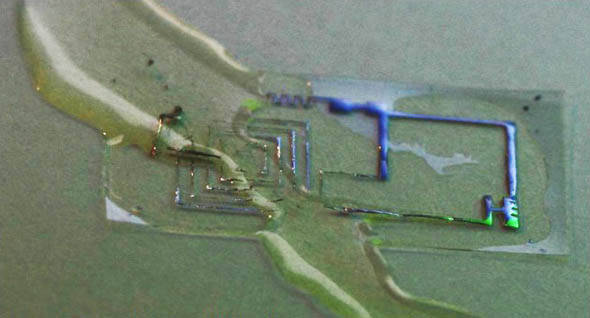Original URL: https://www.theregister.com/2012/12/11/bio_integrated_electronics/
Bio-integrated circuitry melds man and machine
Flexible circuitry mimics skin, brain, human tissue
Posted in Science, 11th December 2012 18:28 GMT
IEDM If you want to marry rigid silicon with soft, stretchy human tissue, it's best to create silicon devices that can conform, stretch, and live in harmony with living flesh.
So says University of Illinois professor John Rogers, who provided an update on his work with bio-integrated and transient electronics to the attendees of the International Electron Device Meeting (IEDM) on Monday in San Francisco.
Despite the continuing miniaturization of electronics that has enabled computers to move from the industrial few to the pervasively personal multitudes, Rogers is of the opinion that merely shrinking chips might not be the only way to move forward as we innovate ourselves into the increasingly digital future.
After all, he said, chips are rigid – and so are the devices into which they are placed. "If you think about an iPhone," he said, "it's a wonderful tool, but what if you wanted to take this kind of device functionality and wrap it around your brain?"
That "wrapping" would require a new form of brain/tissue interface than that now used by neuroscientists, who interface silicon chips with the human brain by mounting a chip on a substrate that has an array of silicon spikes of various lengths, calibrated to reach specific parts of the brain.
"You take that combined system and you use an air hammer to mount it onto the surface of the brain," Rogers explained. "Problem solved. Now you have a way to accommodate the geometry mismatch between planar and curvilinear because each one of these pins can penetrate to a different depth in the tissue."

Flexible, conformable bio-integrated electronics could be used, as with this sheet of sensors, to monitor heart activity
But the problem really isn't solved all that well. "Of course there are disadvantages associated with that [technique]," he said, "because you destroy the tissue to some levels during the implantation process."
Not only is the destruction of tissue a problem, Rogers said, but there's the "more insidious" problem of the disparate mechanical properties of a silicon device and the brain itself. "Now you essentially have a shard of glass, a sharp pin of glass in a bowl of jello," he said. "And the jello is not static – it's swelling, it's de-swelling, it's rattling around in the head as you walk around."
That rattling around, he said, creates a persistent irritation between the brain and the device, and an ongoing deterioration of the connection due to that irritation.
Referring to the "shard of glass" method of brain/silicon interface, Rogers said, "I don't want to denigrate this. This has been the workhorse for neuroscience research for a couple of decades and it's likely to remain an important part of the toolkit going forward."
But it's not an ideal way to marry microelectronics with the brain – or, for that matter, with any other soft biological tissue. The trick, he said, is to create an interface that is soft, stretchable, shape-conformable, and biocompatible with living tissue.
Accomplishing that goal doesn't require dumping silicon and moving to organic polymers, graphene, carbon nanotubes, or some other material. Rogers and others explored those possibilities for a few years, but he came back to silicon.
One of the reasons that silicon proved to be the best substrate for his bio-integrated devices, he explained, is the simple fact that bendability is a function of thickness, with stiffness increasing by a factor equal to the cube of the thickness.
"Think about a [silicon] wafer with a thickness of about a millimeter," he said. "That corresponds to a bending stiffness of about 10 newton-meters. If you go from one millimeter to 10 nanometers, however, you go from 10 newton-meters to 10 femto-newton-meters because of that cubic scaling – that's 15 orders of magnitude."
In other words, when you create a sheet of silicon that thin, it's highly flexible. "It's nothing but Newtonian scaling," he said, "when you change a parameter like that, by 15 orders of magnitude, it really changes the way you think about the system."
Unfortunately, however, silicon sheets that thin are quite fragile, so they need to be bonded with a less-fragile substrate such as plastic or rubber. Fortunately, the thinner the silicon, the easier it is to bond with another substance without different thermal expansion rates of the two substances causing problems.
What's more, the silicon and its substrate will bond merely by their intermolecular van der Waals forces. No muss, no fuss.
Flexibility is fine, but what about stretchability?
All well and good – but not good enough for bio-integrated electronics. "Think about your skin or your heart or your brain," Rogers said. "These are systems that not only flex, but they also stretch, in the sense that they undergo large strain deformations – and there's no thickness at which you can make silicon in this way that will make it stretchy.
Problem – but one solved by Rogers and his team by taking a page from that much-maligned musical instrument known more for "Lady of Spain" than for microelectronic elegance: the accordion.
The solution was to pre-stretch a silicone rubber substrate, bond the silicon to it, then relax the rubber. What you get is an accordion pleat–type of material – or, as Rogers put it, "it leads to a non-linear buckling instability and the creation of a wavy form of silicon."
The final trick that allowed the creation of circuitry on this stretchy, deformable, durable, bio-friendly substrate was to connect the device's small, discrete functional elements with traces constructed in snaky patterns that could bend and stretch without breaking.

A stretchable silicon-on-silicone substrate requires circuitry to also be able to stretch – hence the snaky traces
"It's all about mechanical engineering," Rogers said. "Instead of using a uniform sheet of silicon or integrated circuit, cut the system into an open spider-web mesh consisting of these very thin, narrow, filamentary serpentine structures, bond the whole thing onto a very low-modulus thin sheet of silicone rubber – maybe 50 kilopascals. And if you do all of that with care to the mechanics, guided by full 3D finite-element modeling simulations, then you can generate integrated circuits in this kind of heterogeneous integrated format that have stress-strain properties almost perfectly matched to the epidermis."
Got that? If not, here's the take-away: using his techniques, a device designer can create pliable, stretchable integrated circuits that can bond to human skin or tissue with no discomfort to the user.
Placing such as device on the skin is simple. The silicon-silicone circuit system is stuck onto a water-soluble plastic film as a mounting surface and placed onto the skin. The mounting surface is then washed away, and the device adheres to the surface merely by van de Waals forces. "No penetrating pins, no glue, no straps, no adhesive tapes," Rogers explained.
Of course, simply applying one of these devices to the skin won't make it permanent. Skin, after all, exfoliates on its own, with new cells constantly regenerating beneath the surface layer. Still, Rogers says that such a device should last about two weeks.
But since it's a fully functional circuit, and not merely, say, an electrode, it can do quite a bit of work during its lifetime, seeing that circuits could contain such devices as transistors, resistors, strain gauges and other sensors, photovoltaics for generating power, RF antennas, and other elements.
As one example of such a device's usage, Rogers suggested placing one upon a person's neck where it could perform electromycography (EMG), measuring the electrical signals of muscle-controlling motor neurons. You could then use the data from the EMG spectrogram, using pattern-matching algorithms to compare it with predetermined speech-pattern spectrograms, and create a user interface, provide control over a prosthesis, or build a speaking device for people with diseases of the trachea.
The user-interface capabilities of the neck-mounted EMG sensor were used by some of Rogers' students to control video games through speech, and an on-hand sensor was built to pilot a quadricopter with hand and fist movements.

In addition to bio-integrated electronics, Rogers has developed 'transient electronics' – circuits that dissolve inside you
A more-serious example that Rogers provided was neonatal care. Currently, if a newborn is in a neonatal ICU, he or she is plugged into a welter of devices through a maze of electrodes. Using a bio-integrated device that was equipped with both sensors and RF capabilities, the level of invasiveness could be reduced significantly. ®
Bootnote
In addition to talking about bio-integrated devices, Rogers also discussed his team's work on what he calls transient electronics – devices that can be implanted, swallowed, or otherwise placed in a body, and which will then dissolve in a predetermined amount of time and be safely absorbed with no ill affects to the subject.
To demonstrate the safety of the silicon and magnesium devices that his group is working on, Rogers produced a edible Colpitts RF oscillator (FM transmitter) that he popped into his mouth and swallowed. "Tastes just like chicken," he told his IEDM audience.